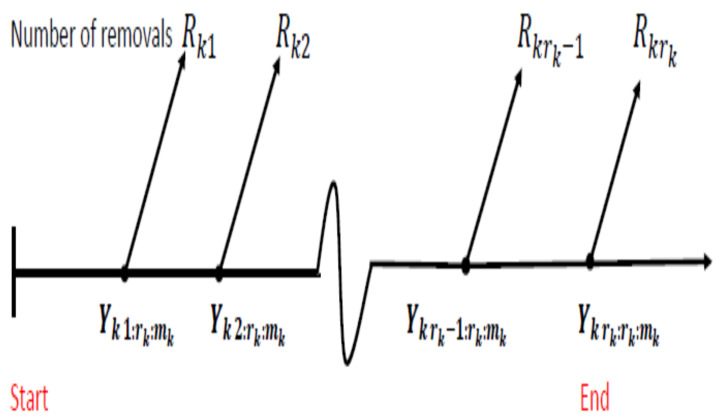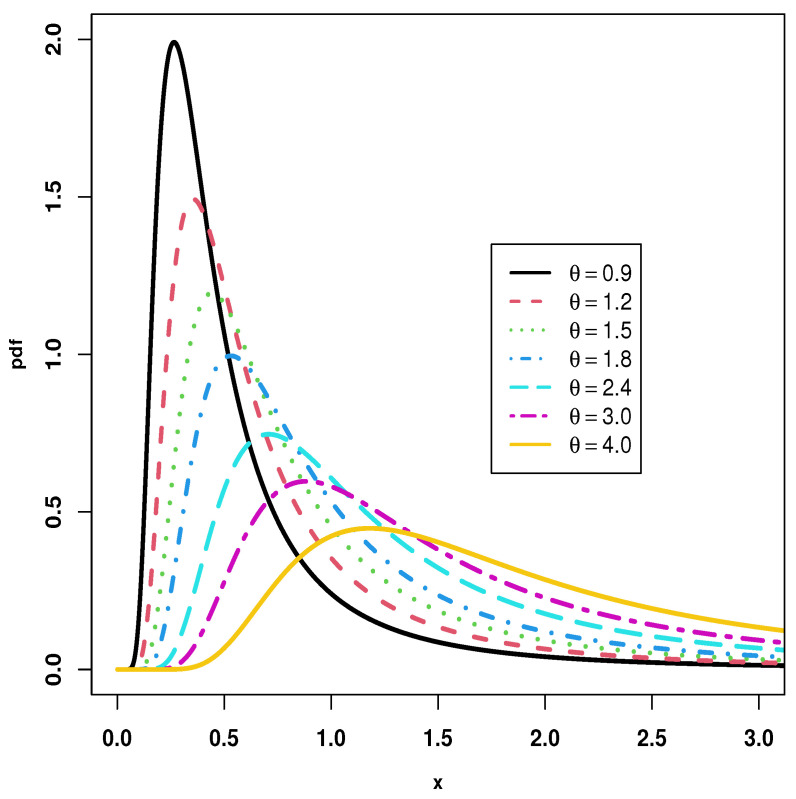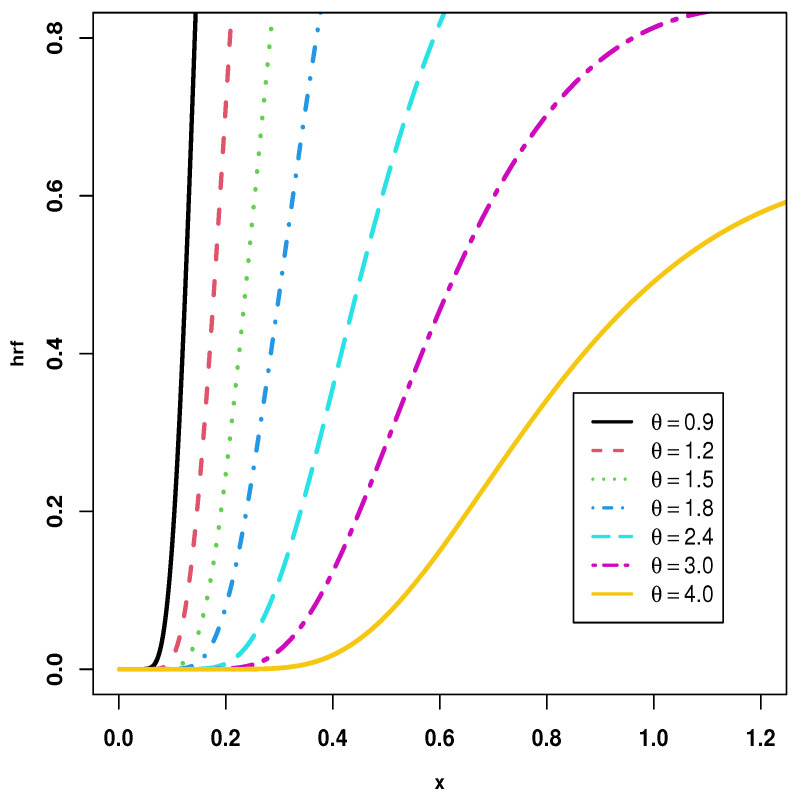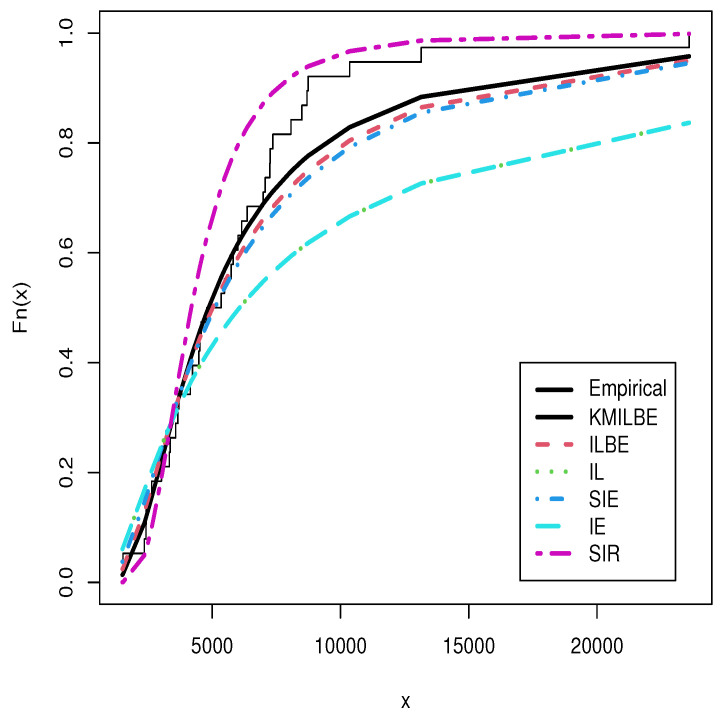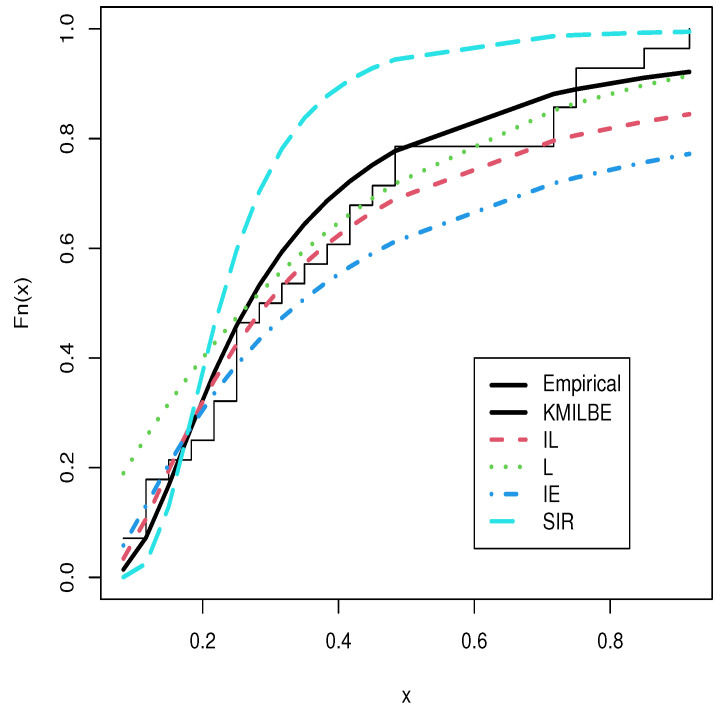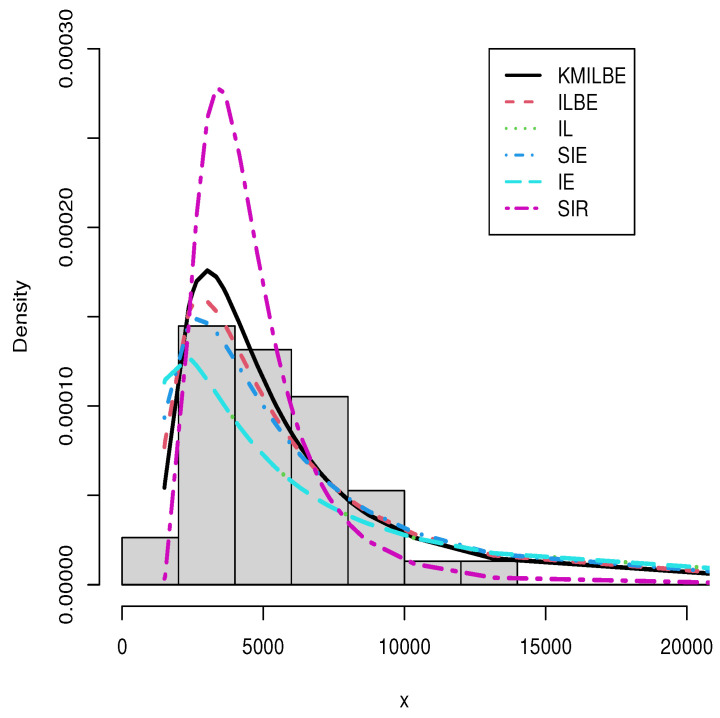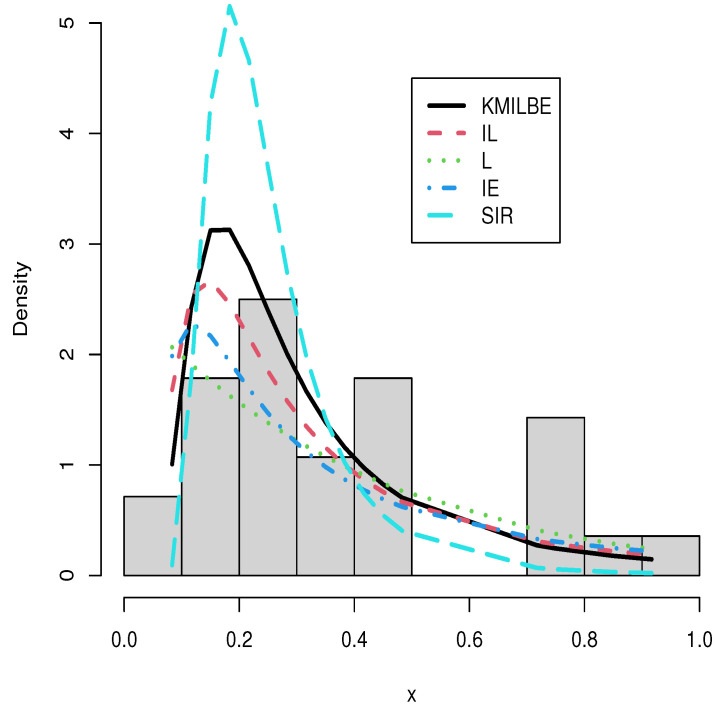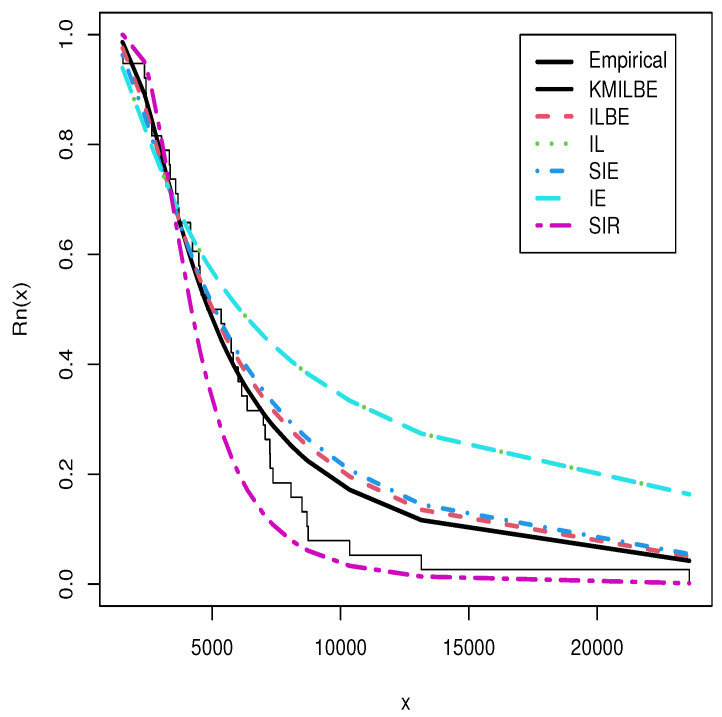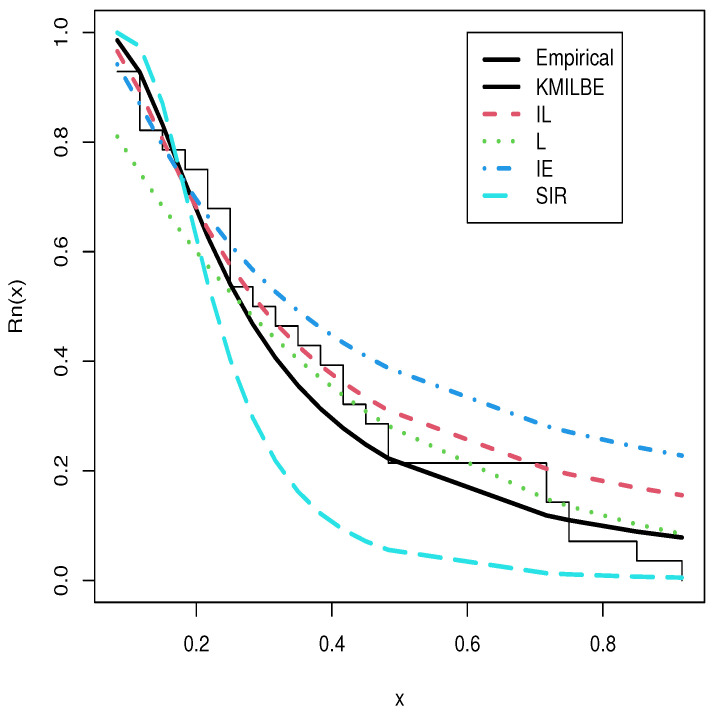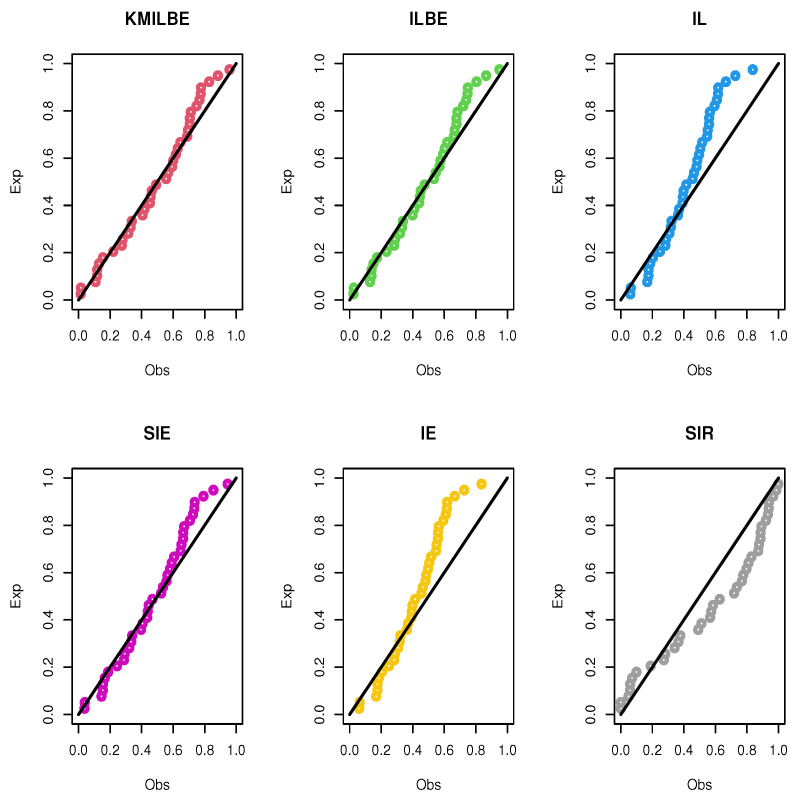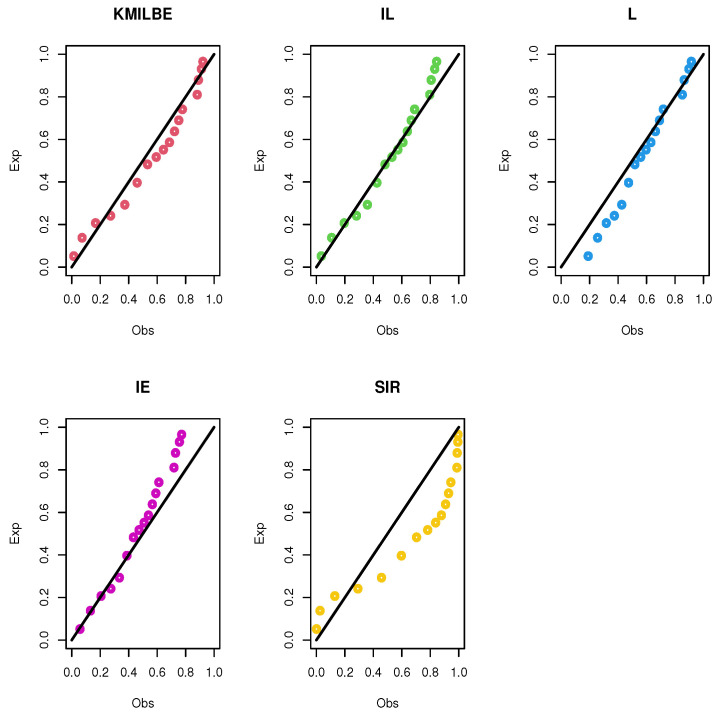Abstract
In this article, a new one parameter survival model is proposed using the Kavya–Manoharan (KM) transformation family and the inverse length biased exponential (ILBE) distribution. Statistical properties are obtained: quantiles, moments, incomplete moments and moment generating function. Different types of entropies such as Rényi entropy, Tsallis entropy, Havrda and Charvat entropy and Arimoto entropy are computed. Different measures of extropy such as extropy, cumulative residual extropy and the negative cumulative residual extropy are computed. When the lifetime of the item under use is assumed to follow the Kavya–Manoharan inverse length biased exponential (KMILBE) distribution, the progressive-stress accelerated life tests are considered. Some estimating approaches, such as the maximum likelihood, maximum product of spacing, least squares, and weighted least square estimations, are taken into account while using progressive type-II censoring. Furthermore, interval estimation is accomplished by determining the parameters’ approximate confidence intervals. The performance of the estimation approaches is investigated using Monte Carlo simulation. The relevance and flexibility of the model are demonstrated using two real datasets. The distribution is very flexible, and it outperforms many known distributions such as the inverse length biased, the inverse Lindley model, the Lindley, the inverse exponential, the sine inverse exponential and the sine inverse Rayleigh model.
Keywords: progressive-stress model, progressive censoring, maximum likelihood estimation, maximum product spacing, Kavya–Manoharan class of distributions, inverse length biased exponential distribution
1. Introduction
Accelerated life tests (ALTs) are applied to gain rapid information on the lifetime distribution of materials or products. In ALTs, the units’ test is performed at higher-than-normal levels of stress (voltage, vibration, pressure, temperature, etc.) to induce early failures. Data obtained at the accelerated conditions are analyzed in terms of an appropriate statistical model and then extrapolated to the specified normal stress to estimate the lifetime distribution in normal use conditions. There are different methods to apply the stress. Commonly used methods are constant-stress, step-stress and progressive-stress; see, for example, Nelson [1], AL-Hussaini and Abdel-Hamid [2,3], Abdel-Hamid and AL-Hussaini [4] and Abdel-Hamid and Hashem [5]. The stress applied to a test product increases in time during a progressive-stress ALT; see Yin and Sheng [6], Abdel-Hamid and AL-Hussaini [7], Abdel-Hamid and Abushal [8], AL-Hussaini et al. [9] and Nadarajah et al. [10].
Censoring has an important role in reliability and lifetime studies when the experimenter can not observe the lifetimes of all test units. Type-I and type-II censoring are two commonly used censoring schemes (CSs); see for example, Mann et al. [11], Meeker and Escobar [12] and Lawless [13]. Progressive type-II censoring, see Figure 1, is considered a generalization of type-II censoring. It allows the experimenter to remove units from a life test at different steps through the experiment. It saves time and cost that may be a consequence of such sampling scheme. For more details on progressive censoring, see Balakrishnan and Sandhu [14], Aggarwala and Balakrishnan [15], Balakrishnan and Aggarwala [16] and Hashem and Alyami [17].
Figure 1.
The process of generating order statistics under progressive type-II censoring.
In recent years, many various statisticians have been drawn to create families of distributions such as Marshall-Olkin-G [18], Kumaraswamy-G (Kum-G) in [19], odd Lomax-G [20], sine- G in [21], odd Dagum-G [22], Type II half logistic-G in [23], transmuted geometric-G [24], odd Perks- G in [25], odd Lindley- G in [26], truncated Cauchy power Weibull-G [27], generalized transmuted-G [28], truncated Cauchy power-G in [29], Burr X-G (BX-G) class [30], transmuted odd Fréchet-G in [31], Type II exponentiated half logistic– G in [32], Topp Leone-G in [33], exponentiated M-G by [34], odd Nadarajah–Haghighi-G in [35], exponentiated truncated inverse Weibull-G in [36] and T-X generator proposed in [37], among others.
Additional parameters give greater flexibility, but they also increase the complexity of estimation. To counter this, Ref. [38] proposed the Dinesh–Umesh–Sanjay (DUS) transformation to obtain new parsimonious classes of distributions. This is as follows. If is the baseline cumulative distribution function (CDF), the DUS transformation generates a new CDF expressed as:
The merit of using this transformation is that the resulting distribution is parameter-parsimonious because no extra parameters are added. In this way, Ref. [39] proposed a new class of distributions that includes many flexible hazard rates. They explored using the DUS transformation using the exponentiated cdf, introducing the generalized DUS (GDUS) transformation. Ref. [40] proposed a generalized lifetime model based on the DUS transformation, with the CDF of the GDUS transformation given by
where The associated density function (PDF) is given by:
where is the baseline distribution in the family distribution. This approach will always create a parsimonious distribution because it is a transformation rather than a generalization, so that no additional parameters beyond those in the baseline distribution are introduced.
Recently, Ref. [41] introduced a new transformation, the KM transformation family of distributions. The CDF and PDF are, respectively,
| (1) |
and
| (2) |
The hazard rate function (HRF) is provided via
| (3) |
Using a given baseline distribution, this family generates new lifetime models or distributions.
Ref. [41] used the exponential and Weibull distributions as baseline distributions because they are widely used in reliability theory and survival analysis.
Ref. [42] presented the length biased exponential (LBE) (or moment exponential (ME) model) by allocating weight to the exponential (E) model. They established that the LBE distribution is more adaptable than the E model. The CDF and PDF files are available:
| (4) |
and
| (5) |
respectively, where is a scale parameter.
The inverse LBE (ILBE) distribution was presented in [43], and it is produced by utilizing the random variable , where X is as follows (5). The CDF and PDF files in the ILBE distribution are specified as
| (6) |
and
| (7) |
The fundamental goal of the article under consideration is to introduce the KMILBE model, as a new one-parameter lifetime model based on the KM transformation family, ILBE distribution, and also to investigate its statistical characteristics. The following points provide sufficient incentive to study the KMILBE distribution. We specify it as follows: (i) It is remarkable to observe the flexibility of the proposed model with the diverse graphical shapes of pdf and hrf. Thus, the the pdf of the KMILBE distribution can be unimodal and right-skewed, with very heavy tails, but the hrf of the KMILBE distribution can be increasing, J-shaped form; (ii) The KMILBE distribution have a closed form of the quantile function; (iii) The KMILBE is a good alternative to several lifetime distributions for modeling skewed data in applications; (iv) Different types of entropy and extropy are computed; (v) Based on progressive type-II censoring, we have discussed some estimation methods on a progressive-stress model when the lifetime of a product follows the KMILBE distribution. The methods that have been discussed are maximum likelihood (ML), least squares (LS), weighted least squares (WLS) and maximum product of spacing (MPS) estimation.
This paper is organized as follows: In Section 2, a new lifetime model using inverse length biased distribution as the baseline distribution in the KM transformation family is presented. In Section 3, we demonstrate the statistical features of the KMILBE model. Different measures of entropy are discussed in Section 4. In addition, some measures of extropy are proposed in Section 5. Model description and progressive type-II censoring by using ML, LS, WLS, and MPS are studied in Section 6. The simulation study and the numerical results are discussed in Section 7. Application to two real datasets is discussed in Section 8. Finally, concluding remarks are proposed in Section 9.
2. Construction of the Kavya–Manoharan Inverse Length Biased Exponential Distribution
In this section, we construct a new flexible distribution called the Kavya–Manoharan transformation inverse length biased exponential (KMILBE) distribution by inserting Equation (6) into Equation (1), to obtain
| (8) |
and the corresponding PDF is
| (9) |
The survival function (SF), HRF, reversed HRF and cumulative HRF for the KMILBE distribution are
and
Figure 2 and Figure 3 show graphical representations of the PDF and the HRF of the KMILBE distribution with various values for the parameter . Forms of the PDF include right skewness and unimodal as shown in Figure 2. In addition, the forms of the HRF include increasing and J- shaped form, as shown in Figure 3. The KMILBE distribution is a very flexible model that provides different distributions when its parameters are changed.
Figure 2.
Different shapes of pdf for KMILBE distribution.
Figure 3.
Different shapes of hrf for KMILBE distribution.
3. Statistical Features of the New Suggested Model
This section provides the structural properties of the KMILBE, defined in Equation (9), including explicit expressions for quantile function (QF), linear representation of the density, rth ordinary and sth incomplete moments, and moment generating function.
3.1. Quantile Function
The QF, say , , is obtained by inverting Equation (8) as follows:
which yields
By multiplying the both sides by , then we have the Lambert equation
Hence, we have the negative Lambert W function of the real argument
| (10) |
where and is the negative Lambert W function. By replacing in Equation (10), the median () of the KMILBE is readily available.
3.2. Useful Expansion
Here, we showed the useful expansion of the pdf, cdf and survival for the KMILBE distribution which can be used to drive several important properties of the KMILBE. According to the next exponential expansion
| (11) |
By inserting the previous Equation (11) in Equation (9), we obtain
by applying the binomial expansion in the last equation, we can rewrite it as follows:
| (12) |
where .
In addition, we can obtain the expansion of by using the last two expansions as follows:
| (13) |
where, .
A gain using the previous expansions, then we can write the expansion of as follows:
| (14) |
where .
3.3. rth Moment
The rth ordinary or raw moments is an important measure to find measures of dispersion of the distribution. The following relationship is used to obtain the central or actual moments; the first moment about mean is always equal to zero, and the second moment about mean is equal to variance as , and . The moment based measure of skewness and kurtosis are obtained by using and , respectively. Suppose that X∼ KMILBE () for and ; then, its rth ordinary moment is given by
Let ; then,
| (15) |
For r = 1, the mean of KMILBE is yielded as .
3.4. Inverse rth Moment
Suppose that X∼ KMILBE () for and ; then, its inverse rth moment is given by
Let ; then,
| (16) |
For r = 1, the harmonic mean of KMILBE is yielded as .
3.5. sth Incomplete Moment
The sth incomplete moment is an important measure and has wide applications in order to compute mean deviation from mean and median, mean waiting time, conditional moments and income inequality measures.
Suppose that X∼ KMILBE () for and ; then, its sth incomplete moments by using (12) and lower incomplete gamma function are given by
| (17) |
3.6. Moment Generating Function
By definition, the moment generating function, , can be yielded as Assume that X∼ KMILBE () for and ; then, its moments generating function can be obtained by using (12) and replacing is given by
| (18) |
where .
4. Entropy Measures
Entropy is a measure of a system’s variation, instability or unpredictability.
4.1. The Rényi Entropy
The Rényi entropy [44] is important in ecology and statistics as an index of diversity. For and , it is defined by the following expression:
| (19) |
By using Equation (13), we obtain
4.2. The Tsallis Entropy
The Tsallis entropy measure (see [45]) is defined by:
| (20) |
By using Equation (13), we obtain
4.3. The Havrda and Charvat Entropy
The Havrda and Charvat entropy measure (see [46]) is defined by:
| (21) |
By using Equation (13), we obtain
4.4. The Arimoto Entropy
The Arimoto entropy measure (see [47]) is defined by:
| (22) |
By using Equation (13), we obtain
5. Different Measures of Extropy
5.1. Extropy
Recently, an alternative measure of uncertainty, named by extropy was proposed by [48]. For an absolutely continuous non-negative random variable X with PDF f and CDF F, the extropy is defined as
| (23) |
By using Equation (13), and putting , we obtain
5.2. The Cumulative Residual Extropy
The cumulative residual extropy (CREX) was proposed by [49] analogous with (23) as a measure of uncertainty of random variables. The CREX is defined as
| (24) |
It is always non-positive. By using Equation (14), we obtain
5.3. The Negative Cumulative Residual Extropy
Refs. [49,50] studied and investigated the negative CREX (NCREX) can be presented as
| (25) |
By using Equation (14), we obtain
6. Model Description and Progressive Type-II Censoring
6.1. Cumulative Exposure Model
The cumulative exposure model (CEM) enables us to relate the distribution under progressive stress to the distribution under constant stress.
If the stress is a function of time y, , and influences the scale parameter of the considered failure distribution, then becomes a function of y, = . Hence, the CEM takes the form; see Nelson [1],
| (26) |
The CDF under progressive stress becomes
| (27) |
where is the assumed CDF with scale parameter equal to 1.
6.2. Basic Assumptions
- First assumption: The relationship between the stress s and the scale parameter satisfies the inverse power law i.e.,
where is the applied stress and (, ) are two positive parameters to be estimated. - Second assumption: The stress is a linearly increasing function in time y, i.e.,
- Third assumption: During the test process, the units to be tested are divided into ℓ() groups; each group includes units and is run under progressive stress. Thus,
Fourth assumption: The failure times, denoted by , , ⋯, , , are statistically independent.
Fifth assumption: The failure mechanisms of the failures are the same under any stress level.
From the first and second assumptions, the CEM (26) takes the form
| (28) |
From (8), CDF (27) under progressive stress takes the form
| (29) |
The corresponding PDF is given by
| (30) |
6.3. Progressive Type-II Censoring
The progressive type-II censoring under progressive stress model can be applied as follows: Under Assumption 3, for 1, …, ℓ, suppose that (<) and , , …, are fixed before the experiment. surviving units are randomly removed from the test, when the first failure time in group k occurs and surviving units are randomly removed from the test when the second failure time in group k occurs. The test continues in the same manner until the -th failure at which all the remaining surviving units = − − are removed from the test, thereby terminating the life-test.
The data from ℓ progressively type-II censored samples are as follows: (; ), …, (; ) where < … < denote the ordered observed failure times, and , …, denote the number of units removed from the experiment at failure times , …, .
Based on ℓ progressively type-II censored samples, under progressive stress ALT, the likelihood function is given by
| (31) |
where y = , = , and ,
Using Equations (29) and (30), the log-likelihood function takes the form
| (32) |
where and
| (33) |
Then, the likelihood equations take the forms
| (34) |
| (35) |
where
| (36) |
| (37) |
The MLEs and of and could be obtained by solving the likelihood equations, and , with respect to and and solving these equations simultaneously to obtain the MLEs. These equations can be numerically solved using iterative techniques using statistical software, since it is not possible for analytical solutions to obtain the roots.
Based on the common asymptotic normality theory of MLEs, we can consider that and can be approximated by a standard normal distribution, i.e.,
where and are the variance of and , which can be obtained from the inverse of the local Fisher information matrix (FIM),
| (38) |
where
| (39) |
where the caret denotes that the derivative is evaluated at . The second partial derivatives of the natural logarithm of the likelihood function with respect to and can be obtained without difficulty.
Suppose that and . Then, for , a normal approximation confidence interval (NACI) for can be defined as
where is the MLE of and is the upper percentile of distribution.
Sometimes, the lower bound of NACI may have a negative value for the positive parameter. Thus, Meeker and Escobar [12] suggested using a log transformation confidence interval (LTCI) for this parameter. The normal approximation of log-transformed MLE, , , can be approximated to a standard normal distribution i.e.,
where .
Therefore, a LTCI for can be defined as
6.4. Least Squares and Weighted Least Squares Estimations
The LS and WLS methods were introduced by Swain et al. [51] to estimate the Beta distribution parameters. Based on progressive type-II censoring, Abdel-Hamid and Hashem [52], and Hashem and Alyami [17], used these two methods to estimate the parameters included in the doubly Poisson-exponential and exponential-doubly Poisson distributions. They can be performed as follows: Let (), , be the ordered progressively type-II censored sample of size from the KMILBE distribution, under progressive stress ALT. The LS estimates (LSEs) of the unknown parameters can be obtained by minimizing the following quantity with respect to the unknown parameters: where is the expectation of the empirical CDF, see Aggarwala and Balakrishnan [15], which is given by
Therefore, the LSEs and of and can be obtained by minimizing the following quantity with respect to and
These estimates can also be obtained by solving the nonlinear equations simultaneously to obtain the LSEs. These equations can be numerically solved using iterative techniques using statistical software since it is not possible for analytical solutions to obtain the roots:
| (40) |
| (41) |
where
| (42) |
| (43) |
and and are given by (33), (36) and (37), respectively.
The WLS estimates (WLSEs) of the unknown parameters can be obtained by minimizing the following quantity with respect to the unknown parameters:
where is the variance of the empirical CDF, see Aggarwala and Balakrishnan [15], which is given by
where
The WLSEs and of and can be obtained by minimizing the following quantity with respect to and
These estimates can also be obtained by solving the nonlinear equations simultaneously to obtain the WLSEs. These equations can be numerically solved using iterative techniques using statistical software since it is not possible for analytical solutions to obtain the roots:
| (44) |
| (45) |
6.5. Maximum Product of Spacing Estimation
Cheng and Amin [53] introduced an alternative method to the ML method for estimating the unknown parameters in univariate continuous distributions. Based on progressive type-II censoring, Ng et al. [54] used this method to estimate the parameters included in the Weibull distribution. The Maximum product of spacing estimates (MPSEs) of the unknown parameters can be obtained by maximizing the following product of spacing with respect to the unknown parameters:
| (46) |
where and .
Using (29), the MPSEs and of and can be obtained by maximizing the following product of spacing with respect to the and
| (47) |
These estimates can also be obtained by solving the nonlinear equations simultaneously to obtain the MPSEs. These equations can be numerically solved using iterative techniques using statistical software since it is not possible for analytical solutions to obtain the roots:
| (48) |
| (49) |
7. Simulation Study
As it is theoretically difficult to assess the efficiency of estimation methods, a Monte Carlo simulation is used to overcome this difficulty. In the current section, through Monte Carlo simulation, we conduct a numerical study to assess the efficiency and performance of the estimation methods according to the following steps:
Assign the values of and .
For , generate a progressively type-II censored sample of size from the KMILBE distribution with CDF (29), according to the algorithm given in Balakrishnan and Sandhu [14].
The MLEs, MPSEs, LSEs, WLSEs, NACIs and LTCIs of the parameters and are computed as shown in Section 2.
Evaluate the 95% NACIs and LTCIs of the parameters and .
Repeat the above steps times.
- If is an estimate of , then the average of estimates, mean squared error (MSE) and relative absolute bias (RAB) of over ℏ samples are given, respectively, by
- Calculate the average of estimates of the parameters and and their MSEs and RABs as shown in Step 5. Calculate also the mean of the MSEs (MMSE) and mean of the RABs (MRAB) according to the following two relations:
Calculate the average interval lengths (AILs) and coverage probability (COVP) of the parameters and .
The following three CSs are considered in the generation of samples:
- CS1: For
- CS2: For
- CS3: For
The computational results are presented in Table 1, Table 2 and Table 3 taking into account the population parameter values: and . For the sake of comparison among the MLEs, MPSEs, LSEs, WLSEs, NACIs and LTCIs of the parameters and , the total number of observations is divided into two groups, , and another time into three groups, .
Table 1.
MLEs and MPSEs of and with their MSEs, RABs, AMSE and ARAB based on 5000 simulations. Population parameter values are and .
| MLE | MPSE | |||||||||||
|---|---|---|---|---|---|---|---|---|---|---|---|---|
| ⋮ | ⋮ | MSE() | RAB() | AMSE | MSE() | RAB() | AMSE | |||||
| ℓ | CS | MSE() | RAB() | ARAB | MSE() | RAB() | ARAB | |||||
| 60 | 2 | 30 | 15 | I | 1.53024 | 0.05812 | 0.12577 | 0.03379 | 1.48487 | 0.04614 | 0.11121 | 0.02773 |
| 30 | 15 | 0.22606 | 0.00947 | 0.37923 | 0.25250 | 0.16227 | 0.00932 | 0.40166 | 0.25644 | |||
| II | 1.53595 | 0.04652 | 0.11181 | 0.02743 | 1.48572 | 0.0377 | 0.10132 | 0.02280 | ||||
| 0.22546 | 0.00834 | 0.35354 | 0.23268 | 0.17043 | 0.0079 | 0.36371 | 0.23251 | |||||
| III | 1.52858 | 0.04054 | 0.10481 | 0.02420 | 1.50566 | 0.03521 | 0.09698 | 0.02144 | ||||
| 0.22350 | 0.00785 | 0.34484 | 0.22482 | 0.18206 | 0.00768 | 0.35259 | 0.22478 | |||||
| 22 | I | 1.52152 | 0.04256 | 0.10759 | 0.02494 | 1.47824 | 0.03525 | 0.09856 | 0.02143 | |||
| 22 | 0.22143 | 0.00731 | 0.33167 | 0.21963 | 0.16431 | 0.00761 | 0.35809 | 0.22832 | ||||
| II | 1.52260 | 0.03679 | 0.10087 | 0.02184 | 1.48067 | 0.03044 | 0.09125 | 0.01886 | ||||
| 0.22222 | 0.00688 | 0.32683 | 0.21385 | 0.16661 | 0.00729 | 0.34808 | 0.21966 | |||||
| III | 1.52217 | 0.03461 | 0.09761 | 0.02055 | 1.50056 | 0.02943 | 0.08901 | 0.01808 | ||||
| 0.22000 | 0.00649 | 0.31635 | 0.20698 | 0.17947 | 0.00672 | 0.33085 | 0.20993 | |||||
| 30 | 1.5168 | 0.03236 | 0.09332 | 0.01928 | 1.47735 | 0.02745 | 0.08799 | 0.01709 | ||||
| 30 | 0.21873 | 0.0062 | 0.30563 | 0.19948 | 0.16573 | 0.00672 | 0.33395 | 0.21097 | ||||
| 3 | 20 | 10 | I | 1.50363 | 0.03188 | 0.09438 | 0.01999 | 1.51203 | 0.02856 | 0.08792 | 0.01866 | |
| 20 | 10 | 0.22289 | 0.00810 | 0.35086 | 0.22262 | 0.15476 | 0.00875 | 0.38819 | 0.23806 | |||
| 20 | 10 | 2 | 1.50703 | 0.02563 | 0.08418 | 0.01633 | 1.50139 | 0.02327 | 0.07961 | 0.01546 | ||
| 0.22049 | 0.00704 | 0.32220 | 0.20319 | 0.16055 | 0.00765 | 0.35851 | 0.21906 | |||||
| III | 1.50395 | 0.02286 | 0.08027 | 0.01485 | 1.51370 | 0.02116 | 0.07502 | 0.01396 | ||||
| 0.22105 | 0.00685 | 0.32158 | 0.20093 | 0.17491 | 0.00675 | 0.33257 | 0.20380 | |||||
| 15 | I | 1.49880 | 0.02440 | 0.08310 | 0.01544 | 1.50236 | 0.02143 | 0.07688 | 0.01451 | |||
| 15 | 0.21841 | 0.00648 | 0.31646 | 0.19978 | 0.15325 | 0.00758 | 0.35827 | 0.21757 | ||||
| 15 | 2 | 1.49920 | 0.02138 | 0.07757 | 0.01355 | 1.50050 | 0.01861 | 0.07160 | 0.01273 | |||
| 0.21803 | 0.00572 | 0.29586 | 0.18671 | 0.16032 | 0.00685 | 0.33739 | 0.20449 | |||||
| III | 1.49764 | 0.02039 | 0.07561 | 0.01307 | 1.51345 | 0.01954 | 0.07235 | 0.01301 | ||||
| 0.21837 | 0.00575 | 0.29681 | 0.18621 | 0.17124 | 0.00649 | 0.32721 | 0.19978 | |||||
| 20 | 1.49669 | 0.01886 | 0.07293 | 0.01200 | 1.50042 | 0.01721 | 0.06919 | 0.01179 | ||||
| 20 | 0.21724 | 0.00514 | 0.28210 | 0.17752 | 0.15833 | 0.00638 | 0.32664 | 0.19791 | ||||
| 20 | ||||||||||||
| 120 | 2 | 60 | 30 | I | 1.51388 | 0.02722 | 0.08678 | 0.01597 | 1.47963 | 0.02448 | 0.08100 | 0.01534 |
| 60 | 30 | 0.21869 | 0.00471 | 0.26997 | 0.17837 | 0.16768 | 0.00619 | 0.31628 | 0.19864 | |||
| II | 1.51637 | 0.02148 | 0.07706 | 0.01271 | 1.48762 | 0.01830 | 0.07010 | 0.01177 | ||||
| 0.21666 | 0.00393 | 0.24826 | 0.16266 | 0.17449 | 0.00524 | 0.28384 | 0.17697 | |||||
| III | 1.51164 | 0.01922 | 0.07291 | 0.01148 | 1.49763 | 0.01640 | 0.06653 | 0.01077 | ||||
| 0.21586 | 0.00374 | 0.23947 | 0.15619 | 0.18138 | 0.00514 | 0.28047 | 0.17350 | |||||
| 45 | I | 1.51019 | 0.02027 | 0.07529 | 0.01200 | 1.48076 | 0.01728 | 0.06912 | 0.01125 | |||
| 45 | 0.21642 | 0.00372 | 0.24067 | 0.15798 | 0.17127 | 0.00523 | 0.28429 | 0.17671 | ||||
| II | 1.51018 | 0.01693 | 0.06818 | 0.01010 | 1.48194 | 0.01505 | 0.06404 | 0.01001 | ||||
| 0.21462 | 0.00327 | 0.22335 | 0.14577 | 0.17236 | 0.00497 | 0.27479 | 0.16941 | |||||
| III | 1.50822 | 0.01656 | 0.06806 | 0.00987 | 1.49334 | 0.01430 | 0.06195 | 0.00952 | ||||
| 0.21470 | 0.00319 | 0.22292 | 0.14549 | 0.17905 | 0.00474 | 0.26336 | 0.16266 | |||||
| 60 | 1.50503 | 0.01562 | 0.06583 | 0.00925 | 1.48008 | 0.01354 | 0.06086 | 0.00913 | ||||
| 60 | 0.21199 | 0.00287 | 0.21081 | 0.13832 | 0.17163 | 0.00472 | 0.26401 | 0.16244 | ||||
| 3 | 40 | 20 | I | 1.50019 | 0.01744 | 0.06979 | 0.01076 | 1.49627 | 0.01484 | 0.06316 | 0.01029 | |
| 40 | 20 | 0.21572 | 0.00408 | 0.25050 | 0.16015 | 0.16160 | 0.00575 | 0.30320 | 0.18318 | |||
| 40 | 20 | II | 1.49748 | 0.01228 | 0.05844 | 0.00778 | 1.49558 | 0.01157 | 0.05601 | 0.00841 | ||
| 0.21360 | 0.00328 | 0.22342 | 0.14093 | 0.16736 | 0.00525 | 0.28359 | 0.16980 | |||||
| III | 1.4987 | 0.01120 | 0.05564 | 0.00720 | 1.50436 | 0.00994 | 0.05191 | 0.00728 | ||||
| 0.2133 | 0.00319 | 0.22129 | 0.13846 | 0.17736 | 0.00461 | 0.26034 | 0.15613 | |||||
| 30 | I | 1.49569 | 0.01219 | 0.05919 | 0.00766 | 1.49418 | 0.01038 | 0.05378 | 0.00773 | |||
| 30 | 0.21293 | 0.00313 | 0.22087 | 0.14003 | 0.16353 | 0.00509 | 0.27838 | 0.16608 | ||||
| 30 | II | 1.49822 | 0.01053 | 0.05469 | 0.00672 | 1.4964 | 0.00948 | 0.05092 | 0.00708 | |||
| 0.21248 | 0.00290 | 0.21068 | 0.13269 | 0.16804 | 0.00467 | 0.2659 | 0.15841 | |||||
| III | 1.49773 | 0.01023 | 0.05395 | 0.00649 | 1.50444 | 0.00910 | 0.05000 | 0.00671 | ||||
| 0.21282 | 0.00275 | 0.20591 | 0.12993 | 0.17605 | 0.00432 | 0.24853 | 0.14926 | |||||
| 40 | 1.49504 | 0.01006 | 0.05334 | 0.00631 | 1.49543 | 0.00879 | 0.04926 | 0.00665 | ||||
| 40 | 0.21165 | 0.00255 | 0.19737 | 0.12535 | 0.16808 | 0.00452 | 0.25882 | 0.15404 | ||||
| 40 | ||||||||||||
Table 2.
LSEs and WLEs of and with their MSEs, RABs, AMSE and ARAB based on 5000 simulations. Population parameter values are and .
| LSE | WLSE | |||||||||||
|---|---|---|---|---|---|---|---|---|---|---|---|---|
| ⋮ | ⋮ | MSE() | RAB() | AMSE | MSE() | RAB() | AMSE | |||||
| ℓ | CS | MSE() | RAB() | ARAB | MSE() | RAB() | ARAB | |||||
| 60 | 2 | 30 | 15 | I | 1.53847 | 0.06934 | 0.13439 | 0.04335 | 1.53427 | 0.06331 | 0.12874 | 0.03884 |
| 30 | 15 | 0.21641 | 0.01736 | 0.50731 | 0.32085 | 0.21840 | 0.01438 | 0.45715 | 0.29294 | |||
| II | 1.51732 | 0.05361 | 0.12044 | 0.03249 | 1.52090 | 0.04666 | 0.11150 | 0.02780 | ||||
| 0.20097 | 0.01137 | 0.41966 | 0.27005 | 0.20462 | 0.00895 | 0.36927 | 0.24038 | |||||
| III | 1.51425 | 0.0442 | 0.10963 | 0.02708 | 1.50998 | 0.04372 | 0.10925 | 0.02647 | ||||
| 0.20677 | 0.00995 | 0.3902 | 0.24992 | 0.20583 | 0.00921 | 0.37535 | 0.24230 | |||||
| 22 | I | 1.51872 | 0.04514 | 0.11151 | 0.02837 | 1.5190 | 0.04271 | 0.10857 | 0.02636 | |||
| 22 | 0.20633 | 0.01159 | 0.42440 | 0.26795 | 0.2079 | 0.01000 | 0.39299 | 0.25078 | ||||
| II | 1.51972 | 0.04161 | 0.10676 | 0.02550 | 1.52121 | 0.04005 | 0.10449 | 0.02426 | ||||
| 0.20480 | 0.00940 | 0.38083 | 0.24380 | 0.20696 | 0.00848 | 0.35906 | 0.23178 | |||||
| III | 1.50950 | 0.03620 | 0.09975 | 0.02273 | 1.50629 | 0.03527 | 0.09861 | 0.02178 | ||||
| 0.20400 | 0.00926 | 0.37892 | 0.23933 | 0.20386 | 0.00829 | 0.35898 | 0.22880 | |||||
| 30 | 1.50890 | 0.03486 | 0.09826 | 0.02191 | 1.51050 | 0.03348 | 0.09626 | 0.02068 | ||||
| 30 | 0.20234 | 0.00896 | 0.37656 | 0.23741 | 0.20341 | 0.00788 | 0.35227 | 0.22426 | ||||
| 3 | 20 | 10 | I | 1.52104 | 0.04246 | 0.10806 | 0.02890 | 1.50653 | 0.03738 | 0.10193 | 0.02512 | |
| 20 | 10 | 0.20537 | 0.01533 | 0.47209 | 0.29008 | 0.20908 | 0.01286 | 0.42851 | 0.26522 | |||
| 20 | 10 | II | 1.51030 | 0.03455 | 0.09766 | 0.02251 | 1.49004 | 0.02921 | 0.09036 | 0.01872 | ||
| 0.19596 | 0.01046 | 0.39092 | 0.24429 | 0.19404 | 0.00822 | 0.34719 | 0.21878 | |||||
| III | 1.48314 | 0.02389 | 0.08204 | 0.01606 | 1.47306 | 0.02442 | 0.08327 | 0.01615 | ||||
| 0.19524 | 0.00822 | 0.36154 | 0.22179 | 0.19357 | 0.00788 | 0.35240 | 0.21783 | |||||
| 15 | I | 1.50977 | 0.02822 | 0.08836 | 0.01917 | 1.50605 | 0.02678 | 0.08647 | 0.01791 | |||
| 15 | 0.19966 | 0.01012 | 0.39540 | 0.24188 | 0.20258 | 0.00904 | 0.37310 | 0.22979 | ||||
| 15 | II | 1.50582 | 0.02343 | 0.08074 | 0.01564 | 1.49757 | 0.02276 | 0.07976 | 0.01501 | |||
| 0.19376 | 0.00784 | 0.35263 | 0.21669 | 0.19517 | 0.00726 | 0.33572 | 0.20774 | |||||
| III | 1.49938 | 0.02156 | 0.07803 | 0.01460 | 1.49095 | 0.02106 | 0.07719 | 0.01403 | ||||
| 0.19593 | 0.00764 | 0.34721 | 0.21262 | 0.19556 | 0.00701 | 0.33306 | 0.20513 | |||||
| 20 | 1.50700 | 0.02206 | 0.07825 | 0.01481 | 1.50702 | 0.02142 | 0.07711 | 0.01415 | ||||
| 20 | 0.19666 | 0.00756 | 0.34261 | 0.21043 | 0.19928 | 0.00687 | 0.32573 | 0.20142 | ||||
| 20 | ||||||||||||
| 120 | 2 | 60 | 30 | I | 1.51221 | 0.03432 | 0.09742 | 0.02172 | 1.51203 | 0.03227 | 0.09424 | 0.01989 |
| 60 | 30 | 0.20471 | 0.00912 | 0.37327 | 0.23535 | 0.20724 | 0.00751 | 0.33737 | 0.21581 | |||
| II | 1.50383 | 0.02803 | 0.08824 | 0.01702 | 1.50708 | 0.02329 | 0.08049 | 0.01389 | ||||
| 0.19879 | 0.00602 | 0.30803 | 0.19813 | 0.20184 | 0.00449 | 0.26468 | 0.17259 | |||||
| III | 1.50401 | 0.02067 | 0.07548 | 0.01277 | 1.50113 | 0.02053 | 0.07543 | 0.01249 | ||||
| 0.20108 | 0.00487 | 0.27445 | 0.17497 | 0.20094 | 0.00446 | 0.26372 | 0.16958 | |||||
| 45 | I | 1.50642 | 0.02376 | 0.08115 | 0.01496 | 1.50792 | 0.02239 | 0.07868 | 0.01380 | |||
| 45 | 0.20144 | 0.00617 | 0.30848 | 0.19481 | 0.20340 | 0.00522 | 0.28293 | 0.18080 | ||||
| II | 1.50260 | 0.01915 | 0.07324 | 0.01181 | 1.50436 | 0.01848 | 0.07197 | 0.01118 | ||||
| 0.19922 | 0.00447 | 0.26620 | 0.16972 | 0.20141 | 0.00389 | 0.24736 | 0.15967 | |||||
| III | 1.50569 | 0.01812 | 0.07102 | 0.01141 | 1.50349 | 0.01764 | 0.07005 | 0.01091 | ||||
| 0.20304 | 0.00469 | 0.27226 | 0.17164 | 0.20301 | 0.00417 | 0.25616 | 0.16310 | |||||
| 60 | 1.50372 | 0.01729 | 0.06921 | 0.01083 | 1.50533 | 0.01641 | 0.06756 | 0.01007 | ||||
| 60 | 0.19946 | 0.00437 | 0.26068 | 0.16495 | 0.20098 | 0.00373 | 0.24079 | 0.15418 | ||||
| 3 | 40 | 20 | I | 1.50804 | 0.02143 | 0.07695 | 0.01448 | 1.50185 | 0.01968 | 0.07387 | 0.01306 | |
| 40 | 20 | 0.19946 | 0.00754 | 0.34122 | 0.20908 | 0.20384 | 0.00644 | 0.31336 | 0.19362 | |||
| 40 | 20 | II | 1.50454 | 0.01655 | 0.06833 | 0.01085 | 1.49144 | 0.01384 | 0.06264 | 0.00881 | ||
| 0.19540 | 0.00515 | 0.28233 | 0.17533 | 0.19518 | 0.00378 | 0.24437 | 0.15350 | |||||
| III | 1.49479 | 0.01226 | 0.05832 | 0.00818 | 1.48801 | 0.01245 | 0.05902 | 0.00814 | ||||
| 0.19821 | 0.00411 | 0.25513 | 0.15673 | 0.19759 | 0.00383 | 0.24634 | 0.15268 | |||||
| 30 | I | 1.50478 | 0.01463 | 0.06361 | 0.00989 | 1.50278 | 0.01389 | 0.06186 | 0.00919 | |||
| 30 | 0.19803 | 0.00516 | 0.28418 | 0.17390 | 0.20082 | 0.00449 | 0.26447 | 0.16316 | ||||
| 30 | II | 1.50127 | 0.012 | 0.05802 | 0.00791 | 1.49621 | 0.01153 | 0.05699 | 0.00746 | |||
| 0.19636 | 0.00382 | 0.24638 | 0.1522 | 0.19791 | 0.00339 | 0.2318 | 0.14439 | |||||
| III | 1.49731 | 0.01125 | 0.05630 | 0.00757 | 1.49163 | 0.01099 | 0.05566 | 0.00724 | ||||
| 0.19674 | 0.00388 | 0.24655 | 0.15142 | 0.19681 | 0.00348 | 0.23349 | 0.14457 | |||||
| 40 | 1.50099 | 0.01069 | 0.05489 | 0.00723 | 1.50081 | 0.01036 | 0.05405 | 0.00684 | ||||
| 40 | 0.19907 | 0.00376 | 0.24161 | 0.14825 | 0.20116 | 0.00331 | 0.22620 | 0.14013 | ||||
| 40 | ||||||||||||
Table 3.
AILs and COVP (in %) of 95% CIs of and based on 5000 simulations. Population parameter values are and .
| NACI | LTCI | |||||||||
|---|---|---|---|---|---|---|---|---|---|---|
| ⋮ | ⋮ | CI() | AIL() | COVP() | CI() | AIL() | COVP() | |||
| ℓ | CS | CI() | AIL() | COVP() | CI() | AIL() | COVP() | |||
| 60 | 2 | 30 | 15 | I | (1.0616,1.9988) | 0.9372 | 95.38 | (1.1268,2.0788) | 0.9521 | 96.04 |
| 30 | 15 | (0.0512,0.4167) | 0.3655 | 96.50 | (0.1017,0.6088) | 0.5071 | 91.40 | |||
| II | (1.1249, 1.9470) | 0.8221 | 95.52 | (1.1754, 2.0074) | 0.8320 | 95.02 | ||||
| (0.0631, 0.3969) | 0.3337 | 94.92 | (0.1090, 0.5386) | 0.4296 | 90.70 | |||||
| III | (1.1427, 1.9144) | 0.7717 | 95.22 | (1.1876, 1.9676) | 0.7800 | 94.80 | ||||
| (0.0652, 0.3898) | 0.3246 | 95.12 | (0.1095, 0.5157) | 0.4062 | 90.88 | |||||
| 22 | I | (1.1251, 1.9179) | 0.7928 | 95.02 | (1.1726, 1.9745) | 0.8018 | 94.94 | |||
| 22 | (0.0627, 0.3879) | 0.3252 | 95.28 | (0.1076, 0.5202) | 0.4126 | 91.58 | ||||
| II | (1.1532, 1.8920) | 0.7389 | 95.26 | (1.1946, 1.9408) | 0.7462 | 95.30 | ||||
| (0.0699, 0.3803) | 0.3103 | 95.52 | (0.1119, 0.4848) | 0.3729 | 91.66 | |||||
| III | (1.1632, 1.8811) | 0.7179 | 94.82 | (1.2025, 1.9270) | 0.7246 | 95.04 | ||||
| (0.0697, 0.3757) | 0.3060 | 95.70 | (0.1111, 0.4778) | 0.3667 | 91.96 | |||||
| 30 | (1.1722, 1.8614) | 0.6892 | 94.42 | (1.2086, 1.9037) | 0.6952 | 94.28 | ||||
| 30 | (0.0745, 0.3670) | 0.2925 | 94.64 | (0.1135, 0.4585) | 0.3450 | 91.52 | ||||
| 3 | 20 | 10 | I | (1.1476, 1.8597) | 0.7121 | 94.74 | (1.1867, 1.9055) | 0.7188 | 95.52 | |
| 20 | 10 | (0.0591, 0.3970) | 0.3379 | 95.76 | (0.1057, 0.5599) | 0.4542 | 91.40 | |||
| 20 | 10 | II | (1.1932, 1.8209) | 0.6277 | 94.96 | (1.2237, 1.8560) | 0.6322 | 95.34 | ||
| (0.0682, 0.3785) | 0.3103 | 95.04 | (0.1105, 0.4733) | 0.3628 | 91.18 | |||||
| III | (1.2102, 1.7977) | 0.5876 | 94.18 | (1.2371, 1.8284) | 0.5913 | 94.96 | ||||
| (0.0730, 0.3739) | 0.3009 | 94.94 | (0.1133, 0.4640) | 0.3507 | 90.60 | |||||
| 15 | I | (1.1930, 1.8046) | 0.6116 | 94.28 | (1.2222, 1.8381) | 0.6159 | 94.80 | |||
| 15 | (0.0708, 0.3710) | 0.3002 | 95.38 | (0.1112, 0.4604) | 0.3492 | 91.94 | ||||
| 15 | II | (1.2145, 1.7838) | 0.5693 | 94.06 | (1.2400, 1.8127) | 0.5727 | 94.46 | |||
| (0.0758, 0.3636) | 0.2878 | 95.32 | (0.1141, 0.4402) | 0.3261 | 92.26 | |||||
| III | (1.2197, 1.7756) | 0.5558 | 94.10 | (1.2440, 1.8030) | 0.5590 | 94.64 | ||||
| (0.0776, 0.3622) | 0.2846 | 95.30 | (0.1152, 0.4347) | 0.3195 | 91.70 | |||||
| 20 | (1.2241, 1.7692) | 0.5451 | 94.90 | (1.2475, 1.7957) | 0.5481 | 95.36 | ||||
| 20 | (0.0815, 0.3552) | 0.2737 | 95.70 | (0.1170, 0.4196) | 0.3026 | 91.94 | ||||
| 20 | ||||||||||
| 120 | 2 | 60 | 30 | I | (1.1820, 1.8457) | 0.6637 | 95.70 | (1.2159, 1.8850) | 0.6690 | 95.52 |
| 60 | 30 | (0.0835, 0.3554) | 0.2719 | 95.88 | (0.1186, 0.4170) | 0.2984 | 93.08 | |||
| II | (1.2295, 1.8033) | 0.5738 | 95.78 | (1.2550, 1.8322) | 0.5773 | 95.58 | ||||
| (0.0966, 0.3373) | 0.2407 | 95.42 | (0.1253, 0.3826) | 0.2573 | 92.22 | |||||
| III | (1.2429, 1.7804) | 0.5376 | 95.22 | (1.2654, 1.8058) | 0.5404 | 94.98 | ||||
| (0.0992, 0.3329) | 0.2337 | 94.96 | (0.1266, 0.3752) | 0.2486 | 92.24 | |||||
| 45 | I | (1.2339, 1.7864) | 0.5525 | 95.06 | (1.2577, 1.8134) | 0.5556 | 95.12 | |||
| 45 | (0.0996, 0.3336) | 0.2340 | 95.24 | (0.1270, 0.3756) | 0.2486 | 92.10 | ||||
| II | (1.2534, 1.7669) | 0.5135 | 95.08 | (1.2741, 1.7901) | 0.5160 | 95.12 | ||||
| (0.1043, 0.3252) | 0.2209 | 95.26 | (0.1291, 0.3622) | 0.2331 | 92.88 | |||||
| III | (1.2584, 1.758) | 0.4996 | 94.96 | (1.2780, 1.7799) | 0.5019 | 94.86 | ||||
| (0.1055, 0.324) | 0.2185 | 95.40 | (0.1298, 0.3599) | 0.2301 | 92.46 | |||||
| 60 | (1.2638, 1.7462) | 0.4824 | 94.58 | (1.2822, 1.7667) | 0.4845 | 94.88 | ||||
| 60 | (0.1079, 0.3162) | 0.2084 | 95.00 | (0.1304, 0.3488) | 0.2185 | 93.08 | ||||
| 3 | 40 | 20 | I | (1.2423, 1.7581) | 0.5158 | 94.32 | (1.2633, 1.7816) | 0.5184 | 94.52 | |
| 40 | 20 | (0.0909, 0.3413) | 0.2504 | 95.68 | (0.1218, 0.3919) | 0.2701 | 92.94 | |||
| 40 | 20 | II | (1.2782, 1.7168) | 0.4386 | 94.68 | (1.2935, 1.7337) | 0.4402 | 94.68 | ||
| (0.1028, 0.3246) | 0.2219 | 95.06 | (0.1279, 0.3621) | 0.2342 | 92.52 | |||||
| III | (1.2923, 1.7051) | 0.4129 | 94.62 | (1.3058, 1.7200) | 0.4142 | 94.48 | ||||
| (0.1060, 0.3208) | 0.2148 | 95.06 | (0.1297, 0.3556) | 0.2259 | 92.46 | |||||
| 30 | I | (1.2779, 1.7135) | 0.4356 | 94.72 | (1.2930, 1.7302) | 0.4371 | 95.20 | |||
| 30 | (0.1046, 0.3214) | 0.2168 | 95.46 | (0.1287, 0.3568) | 0.2281 | 93.14 | ||||
| 30 | II | (1.2969, 1.6995) | 0.4027 | 94.84 | (1.3098, 1.7137) | 0.4039 | 95.2 | |||
| (0.1101, 0.3149) | 0.2048 | 94.66 | (0.1319, 0.3462) | 0.2143 | 92.94 | |||||
| III | (1.3014, 1.6941) | 0.3927 | 95.04 | (1.3137, 1.7075) | 0.3938 | 95.50 | ||||
| (0.1116, 0.3141) | 0.2025 | 94.98 | (0.1329, 0.3443) | 0.2114 | 92.98 | |||||
| 40 | (1.3026, 1.6875) | 0.3849 | 94.46 | (1.3145, 1.7004) | 0.3860 | 94.64 | ||||
| 40 | (0.1145, 0.3088) | 0.1943 | 94.90 | (0.1343, 0.3365) | 0.2022 | 93.50 | ||||
| 40 | ||||||||||
- In the case of two groups , we consider
- In the case of three groups , we consider
Numerical Results
From Table 1, Table 2 and Table 3, we observe the following:
The MLEs are better than the LSEs and WLSEs through the AMSEs and ARABs;
The MLEs are better than the MSPEs through the AMSEs and ARABs for the parameter ;
The WLSEs are better than the LSEs through the AMSEs and ARABs;
The MPSEs are better than the LSEs and WLSEs through the AMSEs;
The NACLs are better than the LTCIs via the AILs and COVP;
For , and fixed values of the total number of items to be tested, , and hence fixed sample sizes, , by increasing the failure times, , the MSEs, AMSEs, RABs, ARABs and AILs of the considered parameters decrease.
For , and fixed values of the failure times, (=50%, 75% and of the sample size ), by increasing the total number of items to be tested, , the MSEs, AMSEs, RABs, ARABs and AILs of the considered parameters decrease.
For fixing the total number of items to be tested, by increasing ℓ, the MSEs, AMSEs, RABs and ARABs decrease.
By increasing the sample and failure time sizes (, ), the COVP are close to 95%.
For fixed values of the sample and failure time sizes (, ), the third CS gives more accurate results through the MSEs, AMSEs, RABs, ARABs and AILs than the other two CSs.
The above results are satisfied except for some rare cases; this may be due to fluctuation in the data.
8. Real Data Analysis
In this section, we illustrate the importance of the newly KMILBE distribution by utilizing two real-life datasets. We shall compare the fits of the KMILBE distribution with the following competing continuous distributions, which are reported in Table 4.
Table 4.
The competing continuous models of the KMILBE distribution with their pdfs and cdfs.
| Models | Abbreviation | CDF | |
|---|---|---|---|
| Inverse length biased exponential | ILBE | ||
| Sine inverse exponential | SIE | ||
| Sine inverse Rayleigh | SIR | ||
| Inverse Lindley | IL | ||
| Lindley | L | ||
| Inverse exponential | IE |
The fitted distributions are compared using the negative maximum log-likelihood (-LL), Akaike information criterion (AIC), corrected AIC (CAIC), Bayesian information criterion (BIC), Hannan Quinn information criterion Kolmogorov–Smirnov test (KS) and p-value (PV).
The first data set we consider in this paper is taken from [55]: 1501.82, 6989.43, 2424.02, 4150.29, 8693.35, 2643.77, 13,148.37, 6149.39, 23,587.21, 7248.37, 4788.22, 6009.51, 5349.65, 5741.32, 7065.81, 7261.37, 2358.42, 10,357.88, 2499.05, 3022.90, 4234.86, 4482.03, 6363.71, 3329.91, 8740.47, 3664.95, 4515.97, 8497.71, 4569.89, 8069.63, 7366.79, 1525.41, 3363.02, 2420.57, 3576.74, 3708.05, 5819.12, 5479.38. These data are carbon retained by leaves measured in kilogram/hectare for thirty-eight different plots of mountainous regions of Navarra (Spain), depending on the forest classification: areas with ninety percent or more beech trees (Fagus Sylvatica) are labeled monospecific, while areas with many species of trees are labeled multi specific.
The second data set: we consider data of times to infection of kidney dialysis patients in months, as described by [56]. The “times of infection” data set is: 2.5, 2.5, 3.5, 3.5, 3.5, 4.5, 5.5, 6.5, 6.5, 7.5, 7.5, 7.5,7.5, 8.5, 9.5, 10.5, 11.5, 12.5, 12.5, 13.5, 14.5, 14.5, 21.5, 21.5, 22.5, 22.5, 25.5, 27.5. Now, we make a normalization operation by divided these data by 30, to obtain data between 0 and1. The transformed data set becomes: 0.08333333, 0.08333333, 0.11666667, 0.11666667, 0.11666667, 0.15000000, 0.18333333,0.21666667, 0.21666667, 0.25000000, 0.25000000, 0.25000000, 0.25000000, 0.28333333, 0.31666667,0.35000000, 0.38333333, 0.41666667, 0.41666667, 0.45000000, 0.48333333, 0.48333333, 0.71666667,0.71666667, 0.75000000, 0.75000000, 0.85000000, 0.91666667.
The MLEs of the competing continuous models, standard errors (SEs), and goodness-of-fit measures are listed in Table 5 and Table 6 for the both datasets, respectively. For visual comparisons, the fitted CDF of the competitive distributions are depicted in Figure 4 and Figure 5, the fitted PDF of the competitive distributions are depicted in Figure 6 and Figure 7, the fitted sf of the competitive distributions are depicted in Figure 8 and Figure 9 respectively. Furthermore, P-P (probability–probability) plots of fitted distributions are displayed in Figure 10 and Figure 11 for the analyzed datasets, respectively. The findings in Table 5 and Table 6 illustrate that the KMILBE model provides a superior fit over other competing continuous models, since it has the lowest values for all measures and lowest value of the Kolmogorov–Smirnov distance (KS).
Table 5.
The goodness of fit tests for data set 1.
| Models | -LL | AIC | CAIC | BIC | HQIC | KS | PV | MLE and SE |
|---|---|---|---|---|---|---|---|---|
| KMILBE() | 357.423 | 716.845 | 716.956 | 716.425 | 717.428 | 0.1444 | 0.407 | 10,190 (1048.837) |
| ILBE() | 358.278 | 718.556 | 718.667 | 718.136 | 719.139 | 0.1715 | 0.213 | 8414 (965.099) |
| SIE() | 359.098 | 720.196 | 720.307 | 719.776 | 720.779 | 0.1848 | 0.1491 | 5602 (696.008) |
| SIR() | 362.625 | 727.251 | 727.362 | 726.831 | 727.834 | 0.2182 | 0.0536 | 4389 (270.107) |
| IE() | 367.001 | 736.002 | 736.336 | 735.582 | 736.585 | 0.3031 | 0.0019 | 4207 (682.428) |
| IL() | 367.001 | 736.002 | 736.336 | 735.582 | 736.585 | 0.3031 | 0.0019 | 4208 (682.428) |
Table 6.
The goodness of fit tests for data set 2.
| Models | -LL | AIC | CAIC | BIC | HQIC | KS | PV | MLE and SE |
|---|---|---|---|---|---|---|---|---|
| KMILBE() | −2.205 | −2.411 | −2.257 | −2.964 | −2.003 | 0.1375 | 0.665 | 0.562 (0.069) |
| SIR() | 10.921 | 23.842 | 23.996 | 23.289 | 24.249 | 0.30611 | 0.0105 | 0.237 (0.017) |
| IE() | 1.248 | 4.496 | 4.958 | 3.943 | 4.903 | 0.2279 | 0.1091 | 0.237 (0.045) |
| IL() | −1.167 | −0.334 | −0.181 | −0.887 | 0.073 | 0.1554 | 0.5084 | 0.406 (0.055) |
| L() | 0.294 | 2.588 | 2.742 | 2.742 | 2.996 | 0.18995 | 0.2645 | 3.27 (0.520) |
Figure 4.
The fitted cdf plots for the data set 1.
Figure 5.
The fitted cdf plots for data set 2.
Figure 6.
The fitted pdf plots for the data set 1.
Figure 7.
The fitted pdf plots for data set 2.
Figure 8.
The fitted sf plots for data set 1.
Figure 9.
The fitted sf plots for data set 2.
Figure 10.
The P-P plots of the competing continuous models for data set 1.
Figure 11.
The P-P plots of the competing continuous models for data set 2.
9. Conclusions
In this study, we explore a new one parameter model, which is called a Kavya–Manoharan inverse length biased exponential model. Its statistical and mathematical features (quantile, moments, inverse moments, incomplete moments and moment generating function) are derived. Different types of entropies such as Rényi entropy, Tsallis entropy, Havrda and Charvat entropy and Arimoto entropy are computed. Different measures of extropy such as extropy, cumulative residual extropy and the negative cumulative residual extropy are computed. Based on progressive type-II censoring, we have discussed some estimation methods on the progressive-stress model when the lifetime of a product follows the Kavya–Manoharan inverse length biased exponential distribution. The methods that have been discussed are ML, MPS, LS and WLS estimations. The approximate CIs for the unknown parameters have been established. The performance of these methods has been investigated through a simulation study, based on three different progressive CSs. The relevance and flexibility of the KMILBE model are demonstrated using two real datasets.
Author Contributions
Conceptualization, I.E. and A.F.H.; methodology, I.E. and A.F.H.; software, A.F.H. and M.E.; validation, N.A., A.S.A.-M., S.A.A., M.E. and I.E; formal analysis, A.F.H.; resources, I.E.; data curation, I.E., N.A. and A.S.A.-M.; writing—original draft preparation, I.E., A.F.H. and M.E.; writing—review and editing, N.A. and S.A.A. and M.E.; funding acquisition, I.E., N.A. and S.A.A. All authors have read and agreed to the published version of the manuscript.
Informed Consent Statement
Informed consent was obtained from all subjects involved in the study.
Data Availability Statement
Data sets are available in the application section.
Conflicts of Interest
The authors declare no conflict of interest.
Funding Statement
The authors extend their appreciation to the Deanship of Scientific Research at Imam Mohammad Ibn Saud Islamic University for funding this work through Research Group No. RG-21-09-10.
Footnotes
Publisher’s Note: MDPI stays neutral with regard to jurisdictional claims in published maps and institutional affiliations.
References
- 1.Nelson N. Accelerated Testing: Statistical Models, Test Plans and Data Analysis. Wiley; New York, NY, USA: 1990. [Google Scholar]
- 2.AL-Hussaini E.K., Abdel-Hamid A.H. Bayesian estimation of the parameters, reliability and hazard rate functions of mixtures under accelerated life tests. Commun. Statist. Simul. Comput. 2004;33:963–982. doi: 10.1081/SAC-200040703. [DOI] [Google Scholar]
- 3.AL-Hussaini E.K., Abdel-Hamid A.H. Accelerated life tests under finite mixture models. J. Statist. Comput. Simul. 2006;76:673–690. doi: 10.1080/10629360500108087. [DOI] [Google Scholar]
- 4.Abdel-Hamid A.H., AL-Hussaini E.K. Estimation in step-stress accelerated life tests for the exponentiated exponential distribution with type-I censoring. Comput. Statist. Data Anal. 2009;53:1328–1338. doi: 10.1016/j.csda.2008.11.006. [DOI] [Google Scholar]
- 5.Abdel-Hamid A.H., Hashem A.F. Inference for the Exponential Distribution under Generalized Progressively Hybrid Censored Data from Partially Accelerated Life Tests with a Time Transformation Function. Mathematics. 2021;9:1510. doi: 10.3390/math9131510. [DOI] [Google Scholar]
- 6.Yin X.K., Sheng B.Z. Some aspects of accelerated life testing by progressive stress. IEEE Trans. Reliab. 1987;36:150–155. doi: 10.1109/TR.1987.5222320. [DOI] [Google Scholar]
- 7.Abdel-Hamid A.H., AL-Hussaini E.K. Bayesian prediction for type-II progressive-censored data from the Rayleigh distribution under progressive-stress model. J. Statist. Comput. Simul. 2014;84:1297–1312. doi: 10.1080/00949655.2012.741132. [DOI] [Google Scholar]
- 8.Abdel-Hamid A.H., Abushal T.A. Inference on progressive-stress model for the exponentiated exponential distribution under type-II progressive hybrid censoring. J. Statist. Comput. Simul. 2015;85:1165–1186. doi: 10.1080/00949655.2013.868463. [DOI] [Google Scholar]
- 9.AL-Hussaini E.K., Abdel-Hamid A.H., Hashem A.F. One-sample Bayesian prediction intervals based on progressively type-II censored data from the half-logistic distribution under progressive-stress model. Metrika. 2015;78:771–783. doi: 10.1007/s00184-014-0526-4. [DOI] [Google Scholar]
- 10.Nadarajah S., Abdel-Hamid A.H., Hashem A.F. Inference for a geometric-Poisson-Rayleigh distribution under progressive-stress model based on type-I progressive hybrid censoring with binomial removals. Qual. Reliab. Eng. Int. 2018;34:649–680. doi: 10.1002/qre.2279. [DOI] [Google Scholar]
- 11.Mann N.R., Schafer R.E., Singpurwalla N.D. Methods for Statistical Analysis of Reliability and Life Data. Wiley; New York, NY, USA: 1974. [Google Scholar]
- 12.Meeker W.Q., Escobar L.A. Statistical Methods for Reliability Data. Wiley; New York, NY, USA: 1998. [Google Scholar]
- 13.Lawless J.F. Statistical Models and Methods for Lifetime Data. 2nd ed. Wiley; New York, NY, USA: 2003. [Google Scholar]
- 14.Balakrishnan N., Sandhu R.A. A simple simulation algorithm for generating progressive type-II censored samples. Am. Stat. 1995;49:229–230. doi: 10.1080/00031305.1995.10476150. [DOI] [Google Scholar]
- 15.Aggarwala R., Balakrishnan N. Some properties of progressive censored order statistics from arbitrary and uniform distributions with applications to inference and simulation. J. Stat. Plann. Inf. 1998;70:35–49. doi: 10.1016/S0378-3758(97)00173-0. [DOI] [Google Scholar]
- 16.Balakrishnan N., Aggarwala R. Progressive Censoring: Theory, Methods, and Applications. Birkhäuser; Boston, MA, USA: 2000. [Google Scholar]
- 17.Hashem A.F., Alyami S.A. Inference on a New Lifetime Distribution under Progressive Type-II Censoring for a Parallel-Series structure. Complexity. 2021;2021:6684918. doi: 10.1155/2021/6684918. [DOI] [Google Scholar]
- 18.Marshall A., Olkin I. A new method for adding a parameter to a class of distributions with applications to the exponential and Weibull families. Biometrika. 1997;84:641–652. doi: 10.1093/biomet/84.3.641. [DOI] [Google Scholar]
- 19.Cordeiro G.M., De Castro M. A new family of generalized distributions. J. Statist. Comput. Simul. 2011;81:883–893. doi: 10.1080/00949650903530745. [DOI] [Google Scholar]
- 20.Cordeiro G.M., Afify A.Z., Ortega E.M.M., Suzuki A.K., Mead M.E. The odd Lomax generator of distributions: Properties, estimation and applications. J. Comput. Appl. Math. 2019;347:222–237. doi: 10.1016/j.cam.2018.08.008. [DOI] [Google Scholar]
- 21.Kumar D., Singh U., Singh S.K. A New distribution using Sine function- its application to bladder cancer patients data. J. Statist. App. Probab. 2015;4:417–427. [Google Scholar]
- 22.Afify A.Z., Alizadeh M. The odd Dagum family of distributions: Properties and applications. J. Appl. Probab. 2020;15:45–72. [Google Scholar]
- 23.Hassan A.S., Elgarhy M., Shakil M. Type II half-logistic class of distributions with applications. Pak. J. Stat. Oper. Res. 2017;13:245–264. [Google Scholar]
- 24.Afify A.Z., Alizadeh M., Yousof H.M., Aryal G., Ahmad M. The transmuted geometric-G family of distributions: Theory and applications. Pak. J. Statist. 2016;32:139–160. [Google Scholar]
- 25.Elbatal I., Alotaibi N., Almetwally E.M., Alyami S.A., Elgarhy M. On Odd Perks-G Class of Distributions: Properties, Regression Model, Discretization, Bayesian and Non-Bayesian Estimation, and Applications. Symmetry. 2022;14:883. doi: 10.3390/sym14050883. [DOI] [Google Scholar]
- 26.Gomes F., Percontini A., De Brito E., Ramos M., Venancio R., Cordeiro G. The odd Lindley-G family of distributions. Austrian J. Stat. 2017;1:57–79. [Google Scholar]
- 27.Alotaibi N., Elbatal I., Almetwally E.M., Alyami S.A., Al-Moisheer A.S., Elgarhy M. Truncated Cauchy Power Weibull-G Class of Distributions: Bayesian and Non-Bayesian Inference Modelling for COVID-19 and Carbon Fiber Data. Mathematics. 2022;10:1565. doi: 10.3390/math10091565. [DOI] [Google Scholar]
- 28.Nofal Z.M., Afify A.Z., Yousof H.M., Cordeiro G.M. The generalized transmuted-G family of distributions. Commun. Stat. Theory Methods. 2017;46:4119–4136. doi: 10.1080/03610926.2015.1078478. [DOI] [Google Scholar]
- 29.Aldahlan M.A., Jamal F., Chesneau C., Elgarhy M., Elbatal I. The truncated Cauchy power family of distributions with inference and applications. Entropy. 2020;22:346. doi: 10.3390/e22030346. [DOI] [PMC free article] [PubMed] [Google Scholar]
- 30.Yousof H.M., Afify A.Z., Hamedani G.G., Aryal G. The Burr X generator of distributions for lifetime data. J. Stat. Theory Appl. 2017;16:288–305. doi: 10.2991/jsta.2017.16.3.2. [DOI] [Google Scholar]
- 31.Badr M., Elbatal I., Jamal F., Chesneau C., Elgarhy M. The Transmuted Odd Fréchet-G class of Distributions: Theory and Applications. Mathematics. 2020;8:958. doi: 10.3390/math8060958. [DOI] [Google Scholar]
- 32.Al-Mofleh H., Elgarhy M., Afify A.Z., Zannon M.S. Type II exponentiated half logistic generated family of distributions with applications. Electron. J. Appl. Stat. Anal. 2020;13:36–561. [Google Scholar]
- 33.Al-Shomrani A., Arif O., Shawky A., Hanif S., Shahbaz M.Q. Topp–Leone family of distributions: Some properties and application. Pak. J. Stat. Oper. Res. 2016;12:443–451. doi: 10.18187/pjsor.v12i3.1458. [DOI] [Google Scholar]
- 34.Bantan R.A., Chesneau C., Jamal F., Elgarhy M. On the analysis of new COVID-19 cases in Pakistan using an exponentiated version of the M family of distributions. Mathematics. 2020;8:953. doi: 10.3390/math8060953. [DOI] [Google Scholar]
- 35.Nascimento A., Silva K.F., Cordeiro M., Alizadeh M., Yousof H., Hamedani G. The odd Nadarajah–Haghighi family of distributions. Prop. Appl. Stud. Sci. Math. Hung. 2019;56:1–26. [Google Scholar]
- 36.Almarashi A.M., Jamal F., Chesneau C., Elgarhy M. The Exponentiated truncated inverse Weibull-generated family of distributions with applications. Symmetry. 2020;12:650. doi: 10.3390/sym12040650. [DOI] [Google Scholar]
- 37.Alzaatreh A., Lee C., Famoye F. A new method for generating families of continuous distributions. Metron. 2013;71:63–79. doi: 10.1007/s40300-013-0007-y. [DOI] [Google Scholar]
- 38.Kumar D., Singh U., Singh S.K. A method of proposing new distribution and its application to bladder cancer patients data. J. Statist. Appl. Probab. Lett. 2015;2:235–245. [Google Scholar]
- 39.Maurya S.K., Kaushik A., Singh S.K., Singh U. A new class of exponential transformed Lindley distribution and its application to Yarn data. Int. J. Statist. Econo. 2017;18:135–151. [Google Scholar]
- 40.Kavya P., Manoharan M. On a Generalized lifetime model using DUS transformation. In: Joshua V., Varadhan S., Vishnevsky V., editors. Applied Probability and Stochastic Processes. Springer; Singapore: 2020. pp. 281–291. (Infosys Science Foundation Series). [Google Scholar]
- 41.Kavya P., Manoharan M. Some parsimonious models for lifetimes and applications. J. Statist. Comput. Simul. 2021;91:3693–3708. doi: 10.1080/00949655.2021.1946064. [DOI] [Google Scholar]
- 42.Dara T., Ahmad M. Ph.D. Thesis. National College of Business Administration and Economics; Lahore, Pakistan: 2012. Recent Advances in Moment Distributions and Their Hazard Rate. [Google Scholar]
- 43.Almutiry W. Inverted Length-Biased Exponential Model: Statistical Inference and Modeling. J. Math. 2021;2021:1980480. doi: 10.1155/2021/1980480. [DOI] [Google Scholar]
- 44.Rényi A. Proceedings of the Fourth Berkeley Symposium on Mathematical Statistics and Probability, Volume 1: Contributions to the Theory of Statistics. Statistical Laboratory of the University of California; Berkeley, CA, USA: 1960. On measures of entropy and information; p. 767. [Google Scholar]
- 45.Tsallis C. Possible generalization of Boltzmann-Gibbs statistics. J. Statist. Phys. 1988;52:479–487. doi: 10.1007/BF01016429. [DOI] [Google Scholar]
- 46.Havrda J., Charvat F. Quantification method of classification processes, concept of structural a-entropy. Kybernetika. 1967;3:30–35. [Google Scholar]
- 47.Arimoto S. Information-theoretical considerations on estimation problems. Inf. Cont. 1971;19:181–194. doi: 10.1016/S0019-9958(71)90065-9. [DOI] [Google Scholar]
- 48.Lad F., Sanfilippo G., Agro G. Extropy: Complementary dual of entropy. Stat. Sci. 2015;30:40–58. doi: 10.1214/14-STS430. [DOI] [Google Scholar]
- 49.Jahanshahi S., Zarei H., Khammar A. On cumulative residual extropy. Probab. Eng. Inf. Sci. 2020;34:605–625. doi: 10.1017/S0269964819000196. [DOI] [Google Scholar]
- 50.Abdul Sathar E.I., Nair D. On dynamic survival extropy. Commun. Stat.-Theory Methods. 2020;50:1295–1313. doi: 10.1080/03610926.2019.1649426. [DOI] [Google Scholar]
- 51.Swain J.J., Venkatraman S., Wilson J.R. Least-squares estimation of distribution function in Johnson’s translation system. J. Statist. Comput. Simul. 1988;29:271–297. doi: 10.1080/00949658808811068. [DOI] [Google Scholar]
- 52.Abdel-Hamid A.H., Hashem A.F. A new lifetime distribution for a series-parallel system: Properties, applications and estimations under progressive type-II censoring. J. Statist. Comput. Simul. 2017;87:993–1024. doi: 10.1080/00949655.2016.1243683. [DOI] [Google Scholar]
- 53.Cheng R.C.H., Amin N.A.K. Estimating parameters in continuous univariate distributions with a shifted origin. J. the Roy. Statist. Soc. B. 1983;45:394–403. doi: 10.1111/j.2517-6161.1983.tb01268.x. [DOI] [Google Scholar]
- 54.Ng H.K.T., Luo L., Hu Y., Duan F. Parameter estimation of three-parameter Weibull distribution based on progressively type-II censored samples. J. Stat. Comput. Simul. 2012;82:1661–1678. doi: 10.1080/00949655.2011.591797. [DOI] [Google Scholar]
- 55.Ugarte M.D., Militino A., Arnholt A.T. Probability and Statistics with R. Chapman & Hall; London, UK: 2008. [Google Scholar]
- 56.Klein J.P., Moeschberger M.L. Survival Analysis: Techniques for Censored and Truncated Data. Springer; Berlin/Heidelberg, Germany: 2006. [Google Scholar]
Associated Data
This section collects any data citations, data availability statements, or supplementary materials included in this article.
Data Availability Statement
Data sets are available in the application section.



